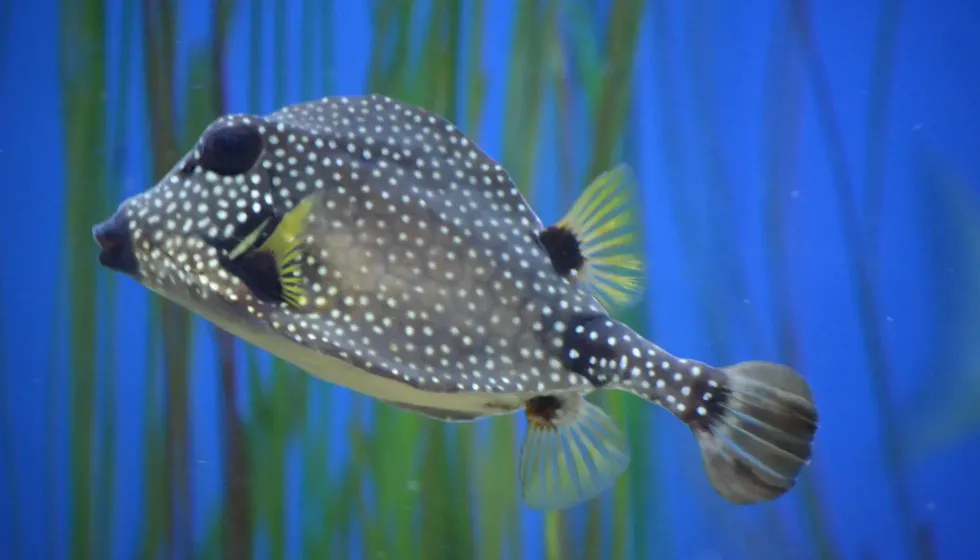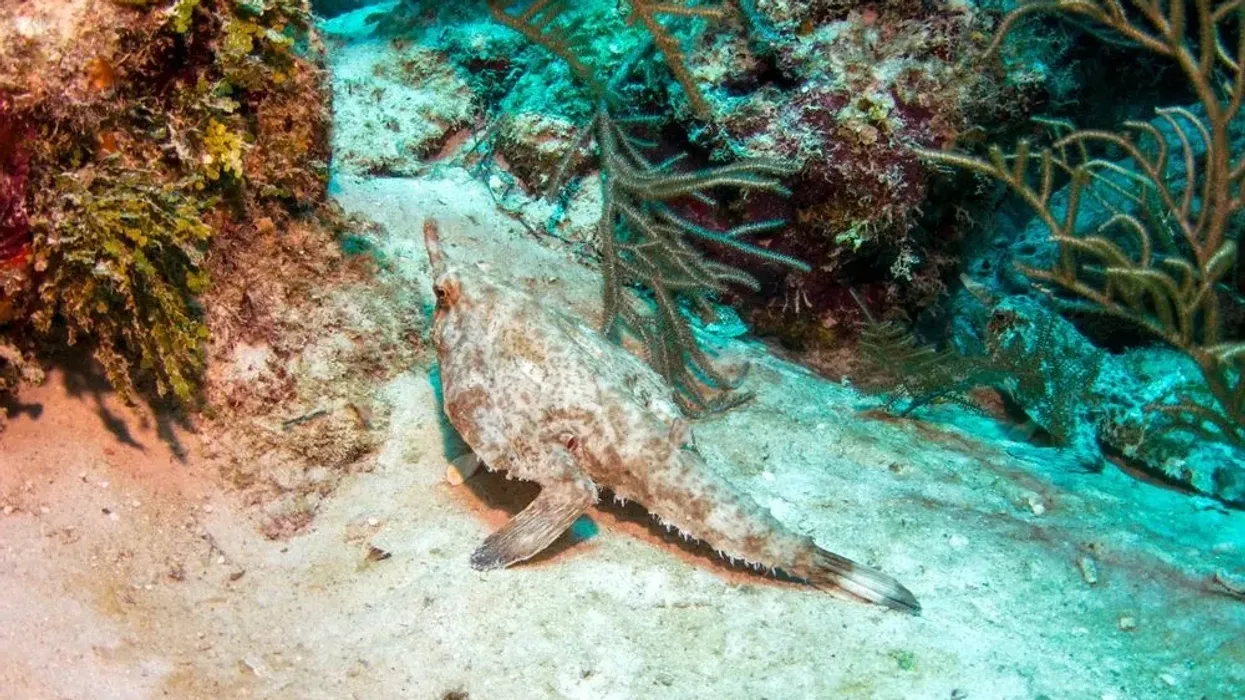The spotted trunkfish is a species of fish found around coral reefs in the Atlantic Ocean. Their range covers from the Caribbean Sea and the Gulf of Mexico to northeastern coastal regions of Brazil.
Spotted trunkfish live at depths of 10-164 ft (3-50 m) and feed on algae, seagrass, and invertebrates. They are small fish that are known for their plate-like, bony, scaly, hard exteriors that are capable of secreting toxins.
This toxin is a defense mechanism as well as a hunting weapon.
The spotted trunkfish uses it to stun prey and defend against predators. The spotted trunkfish is mildly popular in the pet industry but they do not grow as big as they can or breed as successfully as they do in their wild habitats when kept as pets.
They are far from being an endangered or extinct species, holding the status of Least Concern according to the IUCN. They are also known in the Caribbean by the names 'boxfish' and 'cowfish', although these names are also used for other similar species from the family Ostraciidae.
For more great content, check out these Cory catfish facts and channel catfish facts for kids.
Spotted Trunkfish Interesting Facts
What type of animal is a spotted trunkfish?
The spotted trunkfish (Lactophrys bicaudalis) is a fish.
What class of animal does a spotted trunkfish belong to?
The spotted trunkfish (Lactophrys bicaudalis) belongs to the Actinopterygii (ray-finned fish) class of animals.
How many spotted trunkfish are there in the world?
The exact number of spotted trunkfish in the world is unknown, but they are not a threatened species and they have ample wild populations.
Where does a spotted trunkfish live?
Spotted trunkfish (Lactophrys bicaudalis) are abundant in the clear water of the Atlantic Ocean. They are present in the waters of the Caribbean Sea, the Gulf of Mexico, and Ascension Island. They are also found throughout the waters adjacent to northeastern coastal areas in South America, going up to Brazil.
What is a spotted trunkfish's habitat?
The typical spotted trunkfish habitat is in the clear water of the ocean, in and around coral reefs that have fissures, overhangs, and small holes. They also prefer seagrass beds and are seen in ledges and small holes, up to depths of 10-164 ft (3-50 m).
Who do spotted trunkfish live with?
Spotted trunkfish (Lactophrys bicaudalis) are solitary creatures who live alone, except for when they breed.
How long does a spotted trunkfish live?
Spotted trunkfish live for six to 12 years.
How do they reproduce?
Spotted trunkfish reproduction occurs by males and females mating and females laying eggs.
What is their conservation status?
The conservation status of the spotted trunkfish according to the International Union for Conservation of Nature is Least Concern.
Spotted Trunkfish Fun Facts
What do spotted trunkfish look like?
Spotted trunkfish are also called boxfish since they possess an outer covering of hard, plate-like scales. These scales are hexagonal in shape and form a solid box-like or triangular hard, bony outer shell. The snout, fins, tail, and eyes all protrude from this shell.
The spotted trunkfish is an overall white or yellowish color. They have many black spots on their tailfins and bodies.
There are also three white spots behind their eyes. These white spots are in a diagonal row. Their snouts are plain white with spines being absent above the eye, but a couple of defensive and sharp spines are present near the anal fin front.

How cute are they?
Spotted trunkfish aren't very cute animals, but they are definitely interesting to look at. They have a prominent outer shell with bony, hard, plate-like scales. They have polka-dot-like black spots all over their bodies and protruding eyes and snouts. Their skin also expels a colorless toxin, which is only dangerous when touched. Spotted trunkfish are whimsical and fun-looking fish!
How do they communicate?
Like most fish, a spotted trunkfish may communicate via motion and gestures.
How big is a spotted trunkfish?
Spotted trunkfish are 6-12 in (15.2-30.5 cm) long, which makes them four to five times smaller than the length of the Atlantic salmon and four to eight times bigger than the length of a neon tetra.
How fast can a spotted trunkfish swim?
It is unclear exactly how fast a spotted trunkfish can swim, but it is known to be a sluggish swimmer due to its bulky and rigid body. This fish can maneuver itself faster, however, by utilizing its tail fin.
This fish usually does not use the tail fin but uses its anal fins, pectoral fins, and dorsal fins for movement.
How much does a spotted trunkfish weigh?
As a type of boxfish, a spotted trunkfish may weigh around 3.7-7.3 lb (1.7-3.3 kg).
What are the male and female names of the species?
The spotted trunkfish species does not have specific names for males and females.
What would you call a baby spotted trunkfish?
A baby spotted trunkfish is called a 'juvenile' or 'fry' and before this, it is an egg and then a larva.
What do they eat?
The typical spotted trunkfish diet is omnivorous and they eat small invertebrates, crustaceans, mollusks, sea urchins, starfish, sea cucumbers, seagrasses, sessile, tunicates, algae, brittle stars, and crabs. They themselves get preyed upon by larger predators like the nurse shark, but the colorless toxin released by the spotted trunkfish can prove fatal to these sharks!
Are they poisonous?
Yes, spotted trunkfish are poisonous. They are known to secrete a poisonous, colorless toxin when they are touched. Professional divers are generally safe from this though because the toxin is dangerous only when consumed.
However, touching it with bare skin is definitely not safe. This spotted trunkfish poison is capable of killing a much larger fish like a nurse shark, who is a predator of the spotted trunkfish. All fish in the Ostraciidae family are toxic.
Would they make a good pet?
Spotted trunkfish are mildly popular as pets because of their fun appearance and their cute black spots. They are not difficult to take care of either.
The average spotted trunkfish size is 6-12 in (15.2-30.5 cm), which is manageable. They should be provided with room temperature waters between 72-78 F (22.2-25.6 C) and tanks should replicate reefs with a sandy substrate.
They can be kept with non-aggressive fish but these tankmates should not be from their own family. Since they are omnivores, they can be fed with chopped meaty foodstuff and algal or plant foods.
Did you know...
The spotted trunkfish class is Actinopterygii, which roughly translates to 'having fins, wings, and rays'. They are also called ray-finned fishes because they all have rays or bony spines that support their fins.
Different types of trunkfish
The different types of trunkfish belong to two genera in the family Ostraciidae: Lactophrys and Ostracion.
The three species in the Lactophrys genus are the spotted trunkfish, the smooth trunkfish, and the buffalo trunkfish. The Ostracion genus has the bluetail trunkfish and the rough skin trunkfish.
Can you eat trunkfish?
Spotted trunkfish is not safe for consumption since it is known to release a toxin from its skin that is capable of killing large fish like the nurse shark when ingested. Smooth trunkfish, however, are consumed after professional and careful preparation in some parts of the world, but they too can be poisonous.
Buffalo trunkfish is a popular food in many Caribbean islands.
Here at Kidadl, we have carefully created lots of interesting family-friendly animal facts for everyone to discover! Learn more about some other fish from our giant frogfish interesting facts and pigfish surprising facts pages.
You can even occupy yourself at home by coloring in one of our Spotted Trunkfish coloring pages.









